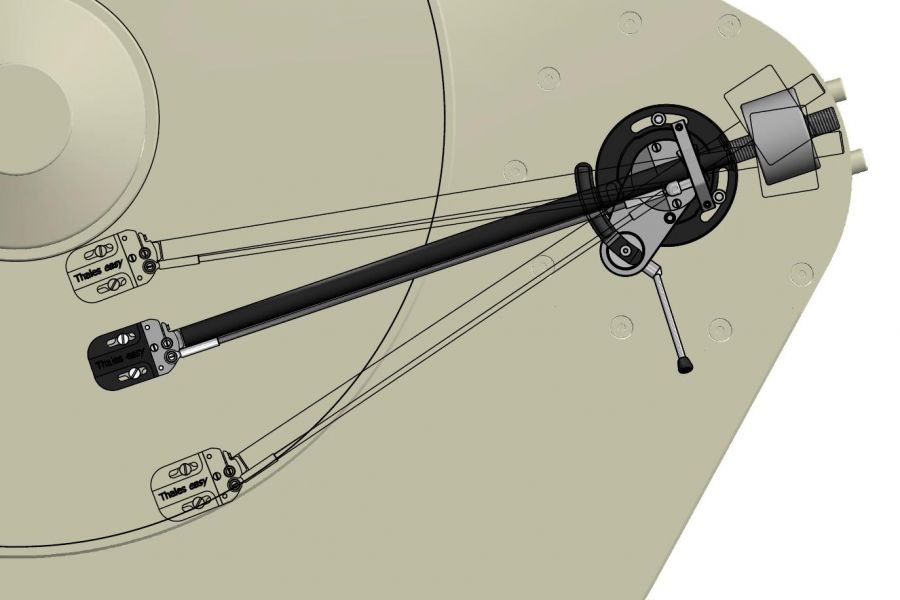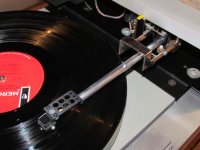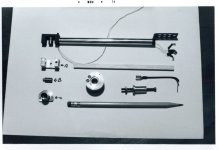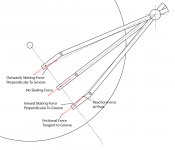Unipivot servo
Been there, done that 42 years ago. Works great!
Ray K
Thanks Ralf.
A little abstract thought. How about mounting a unipivot on a servo controlled linear tracking platform ?
Been there, done that 42 years ago. Works great!
Ray K
Attachments
Arm configuration and eccentricity wow
I believe the answer is no, but the inclusion of an offset angle in conventional pivoted arms does make it worse. If you carefully study the arc swept out by the cartridge as the arm traverses the record, you will see that there is a significant vector component of the movement that is tangent to the groove. As the arm swings out, there is motion 'against' the groove velocity, thus aggravating the relative speed increase from the eccentricity and increasing perceived pitch. As the arm swings in, there is motion 'with' the groove velocity, thus aggravating the relative speed decrease from the eccentricity and decreasing perceived pitch.
It's essentially a mechanical doppler shift. A 9 inch arm has the most, a 12 inch arm has less, a servo driven linear has much less, and an air bearing or mechanical linear would theoretically have none. Note that the key issue affecting the eccentricity wow factor is whether the arm configuration generates motion along the groove as it traverses the record, and not a tangency issue per se.
Ray K
I don't see why an active linear arm cannot move both ways. Note this is different from whether commerical offerings have implemented this.
The eccentricity question is an interesting one. Reducing the 0.55Hz FM that this causes is one of the areas you can really clean up reproduction and this is way more significant that a bit of tracking error. But does any arm configuration mitigate this effect?
I believe the answer is no, but the inclusion of an offset angle in conventional pivoted arms does make it worse. If you carefully study the arc swept out by the cartridge as the arm traverses the record, you will see that there is a significant vector component of the movement that is tangent to the groove. As the arm swings out, there is motion 'against' the groove velocity, thus aggravating the relative speed increase from the eccentricity and increasing perceived pitch. As the arm swings in, there is motion 'with' the groove velocity, thus aggravating the relative speed decrease from the eccentricity and decreasing perceived pitch.
It's essentially a mechanical doppler shift. A 9 inch arm has the most, a 12 inch arm has less, a servo driven linear has much less, and an air bearing or mechanical linear would theoretically have none. Note that the key issue affecting the eccentricity wow factor is whether the arm configuration generates motion along the groove as it traverses the record, and not a tangency issue per se.
Ray K
Been there, done that 42 years ago. Works great!
Ray K
Thats nice. 42 years is a long time
Regards.
Am I correct to think that an eccentric record is no longer tangent on the radius when tracked by a parallel arm? Even when the carriage can react the same time to eccentricity, the tracking point is no longer tangent in relation to the spindle. Every groove is off tangent!
I honestly don't think we need to waste resource and energy on making the servo wander back and forth on following eccentricity. And in this instance I share Conrad Hoffman's sentiment in post#142:
The Nakamichi TX1000 and Dragon turntables with centering ability are ideal for servo or mechanical linear tonearms.
I honestly don't think we need to waste resource and energy on making the servo wander back and forth on following eccentricity. And in this instance I share Conrad Hoffman's sentiment in post#142:
"I don't want to track eccentric records with the servo, be it mechanical or electronic, at least not the normal minor ones. Tangency to that level is not the problem. IMO, that's what people fail to grasp. 0.1 degrees is fine; you should just let the nice pivoted arm do its job. Do not design the servo system to wander back and forth at a 0.555 Hz rate, but keep the response much slower. That doesn't mean increased error if the thing is implemented properly."
The Nakamichi TX1000 and Dragon turntables with centering ability are ideal for servo or mechanical linear tonearms.
Klaudio Tangential Tonearm
Looks like the Klaudio tonearm is a commercial reality. You can check out its instruction manual.
Some observations:
It has two versions: 10.5 inch and 12 inch lengths.
It has no servo, no motor.
It has no pivoting point above the stylus tip.
It has detachable SME style headshell.
It has linear bearing so not only it pivots but also slides back and forth.
It has a complicated guiding mechanism at the base. More pictures from post #1033.
It has dual armwands that reminds people of Thales Simplicity arm.
It has resemblances to Straight Tracker's design.
This thread is mostly about tangential tracking using only pivot bearings so this design is a really a hybrid of using pivot and linear bearing. This is too Rube Goldberg for me (but fun to look at!). And if linear bearings are to be used, I think there are simpler solutions. Some would even argue why not just make a parallel arm already! This arm appears to be a rather belabored way of doing tangential tracking. Hey, at least somebody is making an effort here!

Looks like the Klaudio tonearm is a commercial reality. You can check out its instruction manual.
Some observations:
It has two versions: 10.5 inch and 12 inch lengths.
It has no servo, no motor.
It has no pivoting point above the stylus tip.
It has detachable SME style headshell.
It has linear bearing so not only it pivots but also slides back and forth.
It has a complicated guiding mechanism at the base. More pictures from post #1033.
It has dual armwands that reminds people of Thales Simplicity arm.
It has resemblances to Straight Tracker's design.
This thread is mostly about tangential tracking using only pivot bearings so this design is a really a hybrid of using pivot and linear bearing. This is too Rube Goldberg for me (but fun to look at!). And if linear bearings are to be used, I think there are simpler solutions. Some would even argue why not just make a parallel arm already! This arm appears to be a rather belabored way of doing tangential tracking. Hey, at least somebody is making an effort here!

An externally hosted image should be here but it was not working when we last tested it.
An externally hosted image should be here but it was not working when we last tested it.
An externally hosted image should be here but it was not working when we last tested it.
An externally hosted image should be here but it was not working when we last tested it.
An externally hosted image should be here but it was not working when we last tested it.
Last edited:
The Klaudio arm is somewhat of a parallel arm only at the front end headshell part. All that sliding and pivoting is to move the stylus in a straight line across the record without the carriage moving along laterally like an airbearing or other parallel arms. So this is not exactly in the genre of articulated tonearm a la Garrard Zero 100, Thales Simplicity, or even Schroeder LT. I would assume there is some inherent skating force, however minute, but there's no antiskating device visible.
In this YouTube video, it shows there's a cam system with a guide pin and wire guide, picture below, in the back below the counterweight that helps guiding and moving the whole assembly back and forth on those linear bearings.
A curious device.

In this YouTube video, it shows there's a cam system with a guide pin and wire guide, picture below, in the back below the counterweight that helps guiding and moving the whole assembly back and forth on those linear bearings.
A curious device.

Antiskating is not needed, since the force in play (friction) is perpendicular to the direction of movement.
I'm curious if it has any skating force or not since this is not a traditional parallel tonearm. It has multiple likages and pivot points: from stylus to headshell joint to base pivot and in combination of linear movement. From what I understand, learning from Conrad Hoffman's post, is that if the cantilever to pivot does not form a straight line there will be skating force. In fact all the other articulated arms mentioned have antiskating devices. Maybe it's too minute to matter?
Will it skate?
Very interesting to compare this to a Burne-Jones articulated arm. With the B-J arm, there will be no skating in the middle grooves, but it will skate outwards on the inner grooves and inwards on the outer grooves.
The KLaudio will similarly have no skating in the middle grooves but will skate inwards on the inner grooves and outwards on the outer grooves. The 'does the stylus line up with the pivot' rule is hard to apply since the complex linkage results in a virtual linkage if any. If you study the mechanism motion on the youtube video, notice that the sliding base moves the pivot forward on either side of the 'center grooves' neutral point. If you pushed the sliding base forward with your finger at either of these extremes, you would force the headshell to move in the direction away from the center grooves and the stylus to deflect in the direction towards the center grooves. Stylus friction in the groove will apply a force component on the sliding base the same as your finger pushing on it and the net result will effectively be skating effect that is in opposite directions than the B-J arm.
Bottom line is this arm will skate, although there may be enough friction in all the bearings that the skating effects might get masked.
Ray K
Very interesting to compare this to a Burne-Jones articulated arm. With the B-J arm, there will be no skating in the middle grooves, but it will skate outwards on the inner grooves and inwards on the outer grooves.
The KLaudio will similarly have no skating in the middle grooves but will skate inwards on the inner grooves and outwards on the outer grooves. The 'does the stylus line up with the pivot' rule is hard to apply since the complex linkage results in a virtual linkage if any. If you study the mechanism motion on the youtube video, notice that the sliding base moves the pivot forward on either side of the 'center grooves' neutral point. If you pushed the sliding base forward with your finger at either of these extremes, you would force the headshell to move in the direction away from the center grooves and the stylus to deflect in the direction towards the center grooves. Stylus friction in the groove will apply a force component on the sliding base the same as your finger pushing on it and the net result will effectively be skating effect that is in opposite directions than the B-J arm.
Bottom line is this arm will skate, although there may be enough friction in all the bearings that the skating effects might get masked.
Ray K
Edit:
"The 'does the stylus line up with the pivot rule' is hard to apply since the complex linkage results in a virtual pivot, if any."
Ray K
should read:.....the complex linkage results in a virtual linkage if any.
"The 'does the stylus line up with the pivot rule' is hard to apply since the complex linkage results in a virtual pivot, if any."
Ray K
Last edited:
The KLaudio will similarly have no skating in the middle grooves but will skate inwards on the inner grooves and outwards on the outer grooves. The 'does the stylus line up with the pivot' rule is hard to apply since the complex linkage results in a virtual linkage, if any.
Thank you for your explanation. The variable skating force reminds me of two other similar arms: Thales Easy and JR Audio Impossible arms. Here's a video of the Impossible. I don't think either arm is as tangentially accurate as the Klaudio though, just based on the visuals alone.

An externally hosted image should be here but it was not working when we last tested it.
If you study the mechanism motion on the youtube video, notice that the sliding base moves the pivot forward on either side of the 'center grooves' neutral point.
Yes, I noticed that. If applying Thales semicircle geometry to tonearm, the armwand is like extending its length from the base pivot as it travel closer to the spindle. Since the Klaudio arm uses linear motion bearings, I wish it uses the Thales geometry and it would not even need all the extra linkages, I believe.
Bottom line is this arm will skate, although there may be enough friction in all the bearings that the skating effects might get masked.
Good observation. I agree.
With a conventional tonearm, the friction force has a lateral component in the direction of the movement of the tonearm (the shortest dotted line on the drawing). With the Klaudio tonearm, the friction force has no lateral component, so there is no skating force.


Last edited:
It does, and there is......With the Klaudio tonearm, the friction force has no lateral component, so there is no skating force.
If you extend the dashed friction force line back through the virtual pivot of the KL and apply that force along the constrained motion defined by the sliding mechanism, it will resolve itself into a lateral skating component whose magnitude will vary depending on where the headshell is on the record playing surface. There will be no skating at some 'neutral' position where the arm is fully extended in a straight line, but will gradually develop a lateral skating component as the arm moves away from its 'neutral' position.
You need to carefully study the fore/aft motion of the sliding bearing base in the YouTube video as the arm moves left and right and visualize the effect of the dashed friction force line acting on the bearing base when the arm is at the inner/outer groove extremes. Don't be distracted by the fact that the cartridge may well move across the record surface in a straight line.
Ray K
You are missing the fore/aft motion of the sliding base that moves the arm pivot with it. Your sketch describes the skating forces seen with articulated arms such as the Burne-Jones, Impossible, Van-Epps, etc. Again, you need to study the Klaudio YouTube video.alighiszem,
I believe skating force does exist for Klaudio arm. Please see the drawing.
Jim
Ray K
- Home
- Source & Line
- Analogue Source
- Angling for 90° - tangential pivot tonearms


